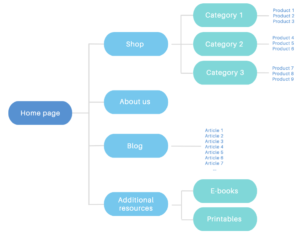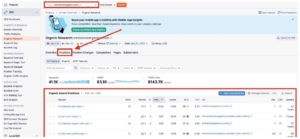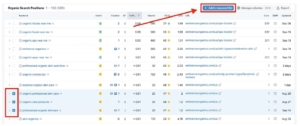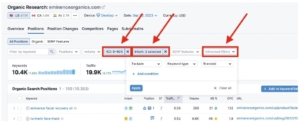Defining a Solid Keyword Strategy
SEO ranking (or SEO search ranking) refers to a page’s position in the search engine results. As seems obvious, the higher your page ranks, the more likely it is that users will click on it.
To date, no one knows exactly what factors Google takes into account when ranking pages. However, over the years, some ranking factors have been officially confirmed, with content relevance being one of them (source).
This is where keyword research comes in. Keyword research is the process of discovering the keyword phrases related to your business that users type into search engines. In other words, it’s figuring out how people will potentially find you online.
Your entire SEO strategy grows from the foundation of solid keyword research. Basically, you can’t make your content relevant to a search query without knowing what to optimize it for.
This is where keyword research comes in. Keyword research is the process of discovering the keyword phrases related to your business that users type into search engines. In other words, it’s figuring out how people will potentially find you online.
Your entire SEO strategy grows from the foundation of solid keyword research. Basically, you can’t make your content relevant to a search query without knowing what to optimize it for.
This document has been created to explain how to develop a keyword strategy for the first time and it is divided into four main chapters:
- Understand your current situation
- Create a list of potential keywords
- Organize and select the best keywords
- Optimize your pages
Once you know how to get started with keyword research, experiment with different websites. Doing the work yourself is the best way to learn.
With time you will be able to move on to more advanced methods and strategies to take your keyword research to the next level.
Some useful articles to start:
VIDEO: How Google Search Works
SEO Ranking: Factors, Tips & Tools to Improve Your Position
Finally, we have highlighted some of the most essential aspects of SEO concerning keyword strategy. These will be referenced many times throughout this guide, so please take the time to digest and retain them.
Relevance is strictly related to search intent.
Keywords can be associated with a search intent. When optimizing our website, our goal won’t be to create content that includes exact match keywords, but rather content that matches the intent of the search.
Similarly, when conducting keyword research, it will not just be about finding the words people use to find a business like yours, but about figuring out the intent that searchers have when looking for you.
We should only have one page associated with a given set of keywords and a given search intent.
This means that, before assigning a keyword to a specific page, we must have a clear understanding of the page structure of our website and the keyword strategy we want to follow.
Related to this, synonyms and related keywords with the same search intent should be considered part of the same keyword set and should be used to enrich the page content, not to create a new one. Otherwise, we risk having cannibalization issues.
We ALWAYS need to keep the user in mind.
Google wants to be relevant to its users. Anything that goes against the user experience (keyword stuffing, over-optimization of content, unnatural wording, etc…) will most likely go against our SEO efforts.
Week 1: Understanding your current situation
- What to do? Analyze the current structure of your website and the keywords you rank for
- Why? It’s a starting point. We need to know our current situation to understand how and what to optimize
- Where? Paper, Miro board (…), Google Search Console, competitive analysis tools
Whether you’re starting a keyword research project for your own business or a client, you can’t start without understanding the current situation.
For this, we will start by creating a diagram of the main pages of our website. Our goal is to get an overall idea about the structure of our website:

Then, we need to see for which keywords each page is currently ranking.
How?
1) Create an Excel spreadsheet with all your pillar pages.
2) Link them with their 5 or 10 top-performing non-branded keywords and write down the number of clicks, impressions and rankings they are currently getting.
To analyze the organic performance of our website, Google Search Console will provide us with the most accurate data. There we will be able to see how each page is performing and for which specific keywords our users are finding them.
3) After completing the previous step, we can proceed to gather supplementary keyword metrics, including search volume and keyword difficulty, using the Keyword Overview tool.
These metrics will help us gain a deeper understanding of our current situation.
To accomplish this, we can utilize the bulk functionality and input up to 100 keywords simultaneously.
In the end, our Excel Sheet could look something like this:

With this document, we can start analyzing the performance of our pages. Our goal is to identify what keywords we rank for and what we can improve.
Depending on the case, we may find several scenarios to which we have to pay special attention:
*Please note that this is an approximation to certain outcomes. Without real data, it is impossible to accurately determine the real causes affecting our performance.
Scenario 1: Low number of clicks and impressions for irrelevant keywords Google is not understanding what the page is about and/or is showing our pages for the wrong search queries.
➔ If it’s an important page for our business, we need to find relevant keywords to optimize the content.
Scenario 2: Really low number of clicks and impressions for relevant keywords but with low search volume.
Our pages rank for keywords with a search volume that is too low to get us enough traffic.
➔ We can try finding related keywords with a higher search volume.
Scenario 3: Low number of clicks and impressions for relevant keywords with high search volume and KD
Our pages may not be well optimized for the search query or we may find it too difficult to rank for these keywords due to their high competitiveness.
➔ First we need to assess our chances of ranking for these keywords. If it’s doable, we need to optimize our content for them. If it’s not, we can try finding related keywords with lower KD.
Scenario 4: Low number of clicks but lots of impressions for relevant keywords
We are probably appearing on the search results page, but users are not clicking on our page.
This may be because we appear in the last positions (for example, the last result on the first page), because Google is displaying the answer on the search results page, or because our title/meta description is not catching the attention of our target audience.
➔ If our content appears on the search results page, Google already understands that our page is at least a bit relevant. We need to study the competitors that are already performing better than us and optimize our page to improve our rankings.
➔ If the answer is displayed on the search results page, we can try to find out if we can increase the number of keywords for which we rank.
➔ Finally, if users do not click on our page because of an irrelevant/uninteresting title or meta description, we have to see how we can improve them.
Tip: In order not to get overwhelmed, if any pages are clearly performing poorly we can focus on them first.
Week 2: Create a list of potential keywords
What to do? Create a list of keywords related to the services or products offered by your company and your main pages (blog, categories…)
Why? Optimizing your pages for these queries and search intentions will help Google understand that what your target audience is looking for is exactly what you offer
Where? Competitive analysis tools
If we want our audience to find us, we need to identify what keywords they use to search for the products or services that our company offers.
In the previous step, we have already identified how we are currently found, but we need to see if there are better keywords for this purpose.
To do this, we can start by analyzing the keyword profiles of our competitors and all those who compete organically with us on Google.
Analyze your competitors’ keyword profiles
The best way to analyze our competition will be through tools designed for this purpose (as we are unable to access our competitors’ real data).
To get started, enter the domain of your competitors in the Organic Research tool and move to the Positions report. There, you will find a list of all the keywords that their site is ranking for and the corresponding pages.

Start scrolling through the list and identify keywords relevant to your business, particularly those with transactional and commercial intent as we focus on the main pages.
For example, if we had skincare e-commerce, we could select the following keywords:
“organic skincare”, “online skincare”, “organic cosmetic products”, “skincare store online”… → For our main page
“face skincare”, “facial skincare”, “face skin products” → For the category of facial skincare
“skincare blogs”, “beauty skincare blog”, “beauty and lifestyle blog” → For our blog page
Whenever we come across interesting keywords, we can add all of them to Keyword Manager by clicking on the “+Add to keyword list” button.

Narrow the search
Use the provided filters to narrow down the search according to search intent. Additionally, we can narrow the search further by selecting only keywords with a low keyword difficulty (%KD) or by excluding all branded keywords from the list.

Experiment with the filters and attempt to identify keywords that are relevant to the categories and subcategories of your website.
Keep in mind that with Organic Research, we can examine the keyword profile of a subfolder or specific page of a competitor’s website.
If we come across pages from your competitors that are similar to the ones we want to optimize, we can copy and paste their URLs, and analyze them using Organic Research.

Refine your list of keywords
It is possible that your competitors are ranking for keywords with high difficulty that you may not be able to rank for.

In this case, search for variations of these keywords with lower difficulty using Keyword Magic tool.
Copy the relevant keywords from the Keyword Manager and input them into the Keyword Magic tool. Experiment with the different filters provided.
When viewing the “Broad Match” tab, filter the keywords to show only those with a Very Easy or Easy keyword difficulty (KD%).
Also, you can filter by the search intent, choosing commercial or transactional intent as we are working with pillar pages:
After that, move to the “Related” tab with the same filters applied.
If you find relevant keywords while navigating your competitors’ keyword profiles, add them to the Keyword Manager.
Don’t forget your purpose
Throughout this process, it is crucial to assess whether the keywords accurately define the purpose of each page.
For example, in the case of the e-commerce website mentioned earlier, a keyword like “steps skincare routine” would most likely not be relevant for the main page, category pages, or sub-categories, as it may imply that the user is looking for information on skin care routines rather than intending to make a purchase.
Such a keyword could be used for an article on how to build a skincare routine that is then linked to our products, but not for the main pages. The previously mentioned keywords are better matches for the pillar pages.
Tip:
If you also want to find keywords for other purposes (for example, for blog posts), create several lists in Keyword Manager and send each keyword to its respective category.
e.g. Let’s go back to the example of the e-commerce that sells cosmetic products. In this case, we could create one list for our Main pages and categories (“organic cosmetics”, “online cosmetics shop”, “skincare face products”…), one for our Products (“anti-aging body lotion”, “jojoba eye cream”…) and one for our Blog ideas (“argan oil benefits”, “basic steps to skin care”…)
If we are not sure who our competitors are or if we did not find interesting keywords, we can search for our domain in Organic Research and move to the Competitors report. There we will find a list of domains with a keyword profile similar to ours and, therefore, can help us discover new keywords.
Additional Resources:
Further information on the different types of keywords and how they can be found How to Search for Keywords for Your Business
The Ultimate Keyword Research Checklist
Week 3: Organize and select the best keywords What to do? Define which keywords can be associated with each page and select the ones you will use to rank Why? Having a well-defined keyword strategy and selecting the right keywords is vital for your search engine rankings
Where? Where we have our list of keywords At this point, we should have two lists of keywords related to our products and main pages: one for the keywords we already rank for and one for the keywords our competitors rank for and related keywords.
Now, our goal will be to organize all these keywords and select the ones we will use to rank. For this:
1) Gather all keywords in one place The first thing we’ll have to do is to unify the two lists we have created. Sometimes, even if we have detected a very profitable keyword for the competition, it will be less expensive and complicated for us to stay with one that we already have. Note that from the first list, we will only select keywords we already rank for that are relevant to our business. Once again, we can use the bulk functionality of Keyword Overview and send all relevant keywords to Keyword Manager.
2) Assign each keyword to a page With the diagram of the main pages of our website in mind, we will start assigning each keyword to the different pages we have. As mentioned, each keyword/intent must be assigned to only one page. Similarly, all synonyms and related keywords (with the same search intent) should be on the
same page. In recent years, Google has made considerable progress in the complexity of its algorithm, which is now capable of interpreting the meaning and different forms of the same keyword. Therefore, it will be very important to work thinking about the meaning and search intent of the search queries, not with the keywords themselves. If we have our list in Keyword Manager, we can simply add the same tag to all keywords that may be associated with a page.
Tip:
When organizing our list of keywords, it will be very useful to also mark those keywords for which we already rank (from the first list). This way, when we select what we will try to rank for, it will be easier to evaluate the current situation of each page and the efforts we need to make. In Keyword Manager, we can add a second tag to this type of keyword (“ranking”, “page 1/page 2”, “weak/strong”…).
3) Select the best keywords
Finally, with our list of keywords sorted, it will be time to analyze each keyword and select the most appropriate one for each page. When going through this process, it’s going to be easier to work page by page. Use the filters that Keyword Manager provides to see only the keywords you have previously assigned to a page.
If there are keywords that you’d like to discard, remove their tag or delete them from your keyword list to start narrowing it down. But at the end… how do I analyze my keywords? The first thing to remember is that keyword analysis is more of an art than an exact science. We will need to dedicate some time to it, especially if we have never done it before, and start little by little.
To evaluate our keywords, we will have to pay attention to four main metrics: search volume, search intent, keyword difficulty and profitability.
● Search volume
Understanding the number of people actively searching for a specific term can provide helpful insight. High-volume keywords (such as “cosmetics”) are usually not the best fit initially as they tend to be too broad and lack specific intent. Also, ranking high enough for these keywords can require much effort, unless you have a notable authority domain. For an initial strategy, a good starting point would be to target mid-range volumes and long-tail keywords for quick success, then gradually work your way up to more competitive terms.
● Search intent
As we previously discussed, content becomes relevant when it matches search intent. Therefore, when choosing which keywords we’ll use to rank, it is very important to evaluate their search intent. To identify keyword intent, we can resort to a research tool such as Semrush. Once you’ve found the keyword intent, look at your pages and try to understand their purpose. This will help us to find out the most appropriate keywords for a given page, as well as to recognize if we need to optimize some of our pages for certain search intentions.
● Keyword difficulty
When conducting this type of research, keyword difficulty is a fundamental metric to consider. If a keyword is too competitive to rank for without investing a lot of resources, you will need to get strategic. Start by aiming for keywords with lower competition that you can realistically rank for, then gradually work your way up to more challenging terms.
● Profitability
When deciding which keywords to target, it is important to consider which ones will actually deliver tangible results. Unless you are an established brand with a large budget, you should focus on what can give you the most benefit in the shortest amount of time. Effective keyword research is more than just picking keywords with high search volumes; it is about finding the right keywords that meet your requirements and goals.
Finally, there are two additional things that we need to take into account. First, always think about your target audience. For example, let’s imagine that the primary target audience for the cosmetic e-commerce is ordinary average women. In this case, keywords such as “bisabolol cream” (instead of “chamomile cream”) or “facial ointment” (instead of “facial cream”) can hardly lead to quality traffic for our business.
Because of this, when conducting keyword analysis, It is important to eliminate keywords leading the wrong audience to your site and incorporate the search terms and topics that your target audience wants instead.
Secondly, be careful with the keywords you already rank for. If we have a page with a good performance, we must be especially careful with the changes we make.
Sometimes we may be getting a lot of users and conversions from several low-volume but good-ranking keywords that belong to the final stage of our funnel.
Don’t dismiss the keywords you already rank for without thoroughly reviewing everything first. After all this work, the ideal would be to have one main keyword for each page and several secondary/related/long-tail keywords associated with it.
Additional Resources:
Keyword Analysis for SEO: How to Analyze Your Keywords A Four-Step Guide on Keyword Mapping to Improve Your SEO and Content Strategy How to Do Keyword Research for SEO: (especially steps 2&3)
Week 4: Optimise your pages
What to do? Optimise your pages for the selected keywords and their search intent
Why? To ensure that Google considers our content to be relevant to our target audience’s search queries
Where? Your website At this point, it is essential to match each page to a specific keyword and intent (commonly referred to as “on-page SEO”).
Here are some vital on-page SEO practices that should be applied to every page of your website.
1. Optimise your title tag
Title tags appear as the title of your page on the search engine results page and are a key ranking factor. At the most basic level, you’ll want to make sure that the title tags of your site’s pages include the main target keyword for the page as far to the left as possible. Also, make sure they are unique, contain keyword variations if possible, and are of appropriate length (no more than 60 characters).
More on how to write title tags.
2. Optimise your meta description
Meta descriptions are the text displayed under the page title on SERPs. They should be unique, concise and paint a clear picture of your page’s content (between 140 to 160
characters).
Include your main keyword and several related words, and add a call to action if relevant.
More on how to write meta descriptions.
3. Optimise your headings tag
Another key on-page SEO factor is heading tags, also referred to as H1–H6 tags. These are used to break up your content into sections.
Ensure your page has appropriately formatted headings and subheadings (H1, H2, etc.) in HTML instead of headers in bolded regular text.
Also, since search engines place special importance on the words that appear in heading tags,
make sure your target keywords and related terms are within the subheadings.
H1 Tag Best Practices
4. Include the main keyword from time to time in your text and enrich the content with related and similar keywords Once you’ve chosen your keywords and determined which pages they should go to, it’s time to add them to the existing content or modify the content to include them. For some keywords, this is straightforward. For example, if you have an article on marathon running shoes, and you want to include the keyword phrase “best long-distance running shoes” it might be as simple as changing an H2
subheading from “Which Shoes are the Best?” to “The Best Long Distance Running Shoes.” Other times, including a particular keyword, seems almost impossible without creating awkward sentences, which brings us to our next tip.
5. Avoid keyword stuffing
Keyword stuffing is the practice of loading an article with keywords but at the expense of the content. It’s important to avoid doing this. While it’s true that more keywords often result in higher search rankings, if those keywords are overused and the content is poor, the effect will be the opposite. Google and other search engines have learned to look out for keyword stuffing and don’t rank stuffed pages highly because their content tends to lack. Search algorithms are always evolving to return relevant and valuable content to a searcher. As such, content quality should always trump keywords.
6. Optimise your images
Both the image file names and alt text for the image are factors considered by search algorithms when determining how to rank and classify your content. Not only that but these increase the accessibility of your site. Ensure the image file name and alt text are relevant and aligned with the content. Use the keywords you’ve found or use search queries that are related to your primary keyword. What you shouldn’t do is force all of your primary keywords into the alt text (aka another form of keyword stuffing).
More on Alt text good practices.
7. Don’t forget to use relevant anchors when pointing to a page Everything that has to do with the article needs to be related to the chosen keywords and topic. This includes the words used in the links that point to a specific page, also known as anchor text. Be relevant when writing your anchor texts, but try to use your keywords and variations of it at every possible opportunity.
Read how to optimize anchor text for SEO.
8. Match search intent Ideally, keywords should be assigned to a page based on search intent. If for some reason a page has a good ranking for a wrong search intent, try to adapt the content a little bit to better respond to the search query. For example, if a page is ranking for an informational keyword but we do not provide much
information, maybe we could consider adding a FAQs section at the end of our page.
Tip:
If you are not sure how to optimize your pages, I would recommend that you take a look at our SEO Content Template and our SEO Writing Assistant. These tools give you a comprehensive and structured list of things that could be done to optimise a page for a given set of keywords. Pay special attention to the recommendations provided and try to understand the logic behind them. Over time, you will feel more confident and find it much easier to optimize your pages for SEO.
Additional Resources:
How to Optimize Your Content Using SEO Content Template
SEO Writing Assistant (user manual)
10 UX Design Examples to Get Inspired


